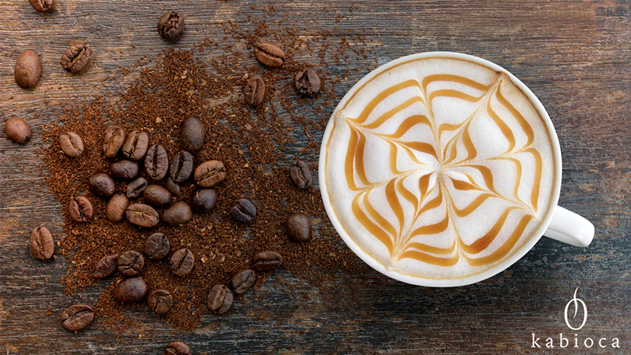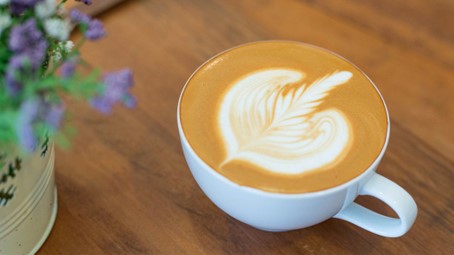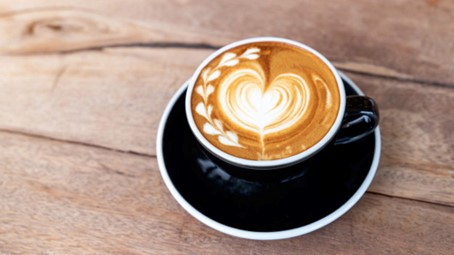
Our tips for a successful Latte Art
Making a good cappuccino is great, but making it beautiful is even better! Have you ever heard of latte art, or tasted it in a coffee shop? Would you also like to draw beautiful patterns on the top of your cappuccino by adding milk and milk foam? Discover our tips on how to make a success of your Latte Art and impress your friends by creating your own designs at home.
What is Latte Art?
Before we tell you how to make a beautiful latte, let’s take a look at the very definition of this art form. Latte is actually short for caffè latte in Italian, meaning coffee with milk. We agree that the word sounds much better in Italian than it does in French!
Latte is a blend of espresso coffee, hot milk and a fine milk foam. As Wikipedia explains, latte art is a technique specific to baristas, enabling them to create designs or patterns on the surface of a latte. The most common shapes are hearts, leaves and tulips.
Successful latte art requires excellent dexterity and artistic sensitivity. Let’s find out how to decorate your coffee with beautiful designs.
How to make frothed milk?
The secret of good frothed milk lies in the type of milk used. It’s as obvious as that! However, you can make frothed milk with any type of milk. It’s the caseins in the liquid (which contain gas) that produce the foam during emulsification. However, the fat content is important, as it gives the foam its creamy texture. It’s best to use whole milk, but if you find it too heavy, use semi-skimmed milk. It’s also possible to make frothed milk from skimmed milk, but this doesn’t offer the same taste pleasure.
There’s only one recipe for good milk foam, but it requires the use of different utensils. The principle is always the same. Pour 125 cl of previously heated milk into a jug, then emulsify the top (i.e. 25% of the milk). Be careful with the container you choose, as the milk is bound to foam! So don’t choose a container that’s too small or has too low a rim, or you’ll risk splashing yourself or your milk overflowing.
Here are the different utensils you’ll need to create your milk foam:
- The steam nozzle
The steam nozzle is the tool of choice for true barista coffee professionals. Directly integrated into good espresso machines, the nozzle is immersed in milk, just below the surface and off-center on the side. It then emulsifies the milk with steam, while heating it. It’s the ideal utensil for obtaining the best froths.
- Automatic milk frother
This small household appliance comes in the form of a vat. Once filled with milk and switched on, it produces a warm, creamy froth without the slightest effort.
- Hand-held emulsifiers
The hand-held emulsifier is a kind of mini electric whisk. Dip it into cold or hot milk, then turn it on to increase the volume of milk. The principle is similar to that of an electric mixer.
- The microwave oven
The microwave oven is an easy homemade trick for obtaining frothed milk. First, pour the cold milk into half a fairly deep container, then close it tightly and shake briskly for 1 minute. Then remove the lid and heat in the microwave for up to 30 seconds. The technique is similar to that of whisking eggs to make a floating island.
Draw a leaf on your coffee
The leaf is one of the basic designs in the world of latte art, but you still need to know how to make it! Pour the milk into your hot coffee, high enough above the cup (about 20 centimetres high). The liquid falls to the bottom, leaving the surface of the coffee still brown. Maintain the flow while gradually approaching the edges of the cup. Once the spout of your container touches the edge of the cup, the pattern begins to appear.
Increase the flow of milk so that a froth forms on the surface of the coffee. Stretch the stream of milk downwards in decreasing strokes, from right to left.
A flick of the wrist is all it takes to form the pattern! Be careful to start with a smaller pattern, as the foam will spread. Once you’ve reached the bottom of the cup, go straight back up to break off the plant’s leaves and form its stem. The leaf will then appear.
It’s likely that you won’t succeed on the first try – after all, you’re not a barista and you need to get the hang of it. You can use a large cup for smoother movements.
Making a heart on the coffee
This is the simplest Latte Art pattern. To make it, take a cup half-filled with coffee. Stand up to pour a small stream of frothed milk into the middle of your coffee cup, and gradually move it closer to the surface with gentle vibrations of the wrist. The milk will flow to the bottom of the cup.
When your cup is two-thirds full :
- Stop moving
- Slightly increase the flow rate, staying in the middle. Your pitcher should be close to the surface and a circle should have formed.
- Then fold it straight back towards the rim nearest you, crossing the circle, and you’ll see a heart appear.
Be careful, if you interrupt your gesture during a step, it won’t work.
You’ve only managed to get a circle of milk?
No problem. The heart is one of the easiest patterns to make, but also to catch up with. Using a toothpick or needle, draw a line through the middle of the circle to create a pretty heart.
With Kabioca capsules for Nespresso machines and Kabioca capsules for Dolce Gusto machines, it’s easy to make your own Latte Art. The creamy froth of our coffees, produced by high-pressure percolation, is the perfect undercoat for all your works of art.
We recommend that you use our lungo, espresso or cappuccino capsules to make your own latte art. Then all you have to do is add your milk foam and start drawing!

